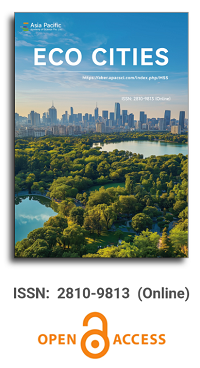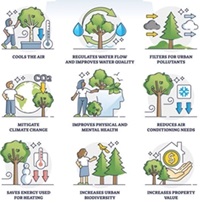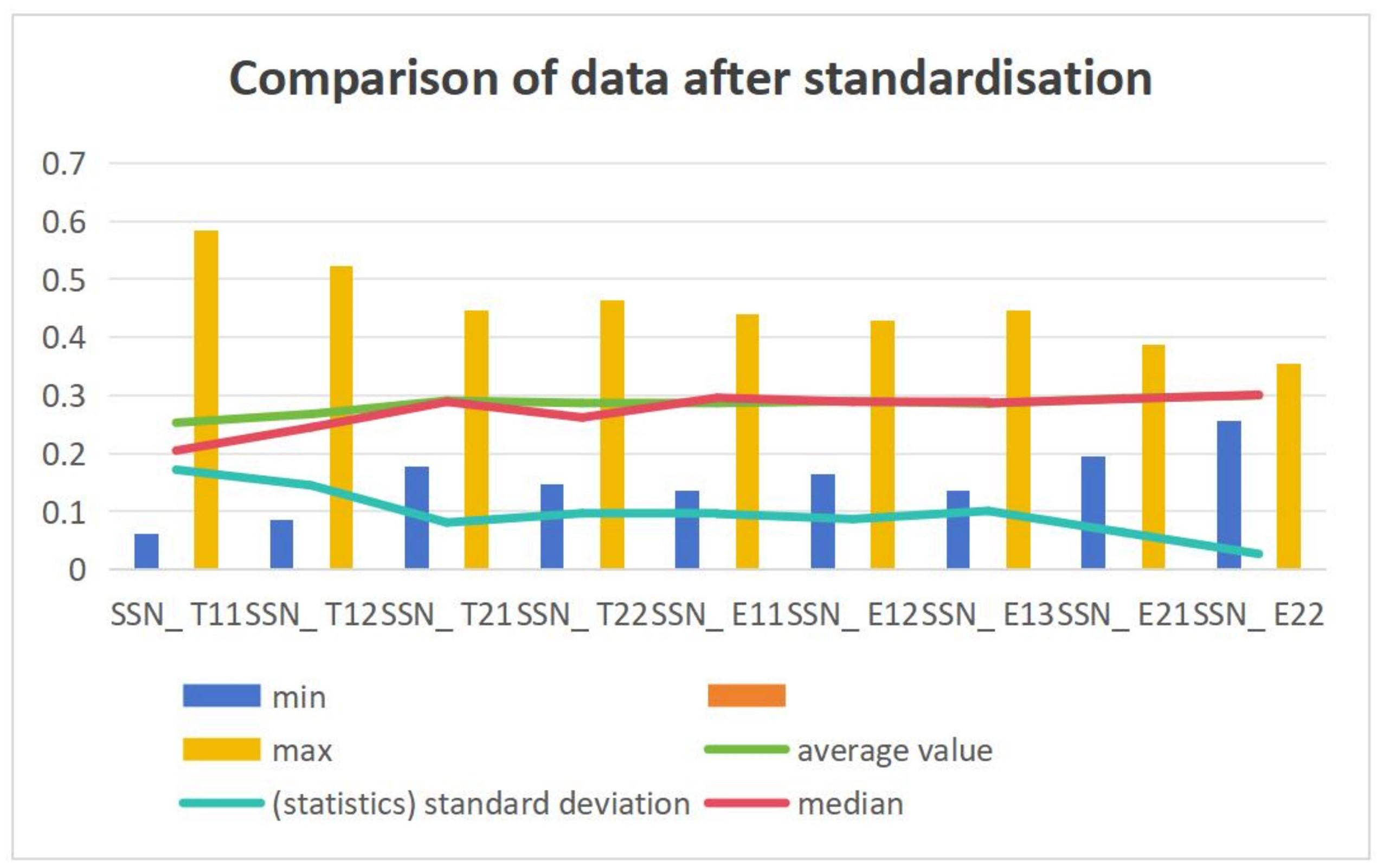
Publication Frequency
Semi-annual
Journal Articles
Search
Search scope
Volume Arrangement
Featured Articles

The exacerbation of climate change impacts within metropolitan areas is a well-documented phenomenon, often leading to severe consequences that pose significant risks to human populations. The impact of urban vegetation and planting design on these factors can be observed. However, it is worth mentioning that while there is an extensive body of literature on the consequences of climate change, there is a relatively small number of studies specifically focused on examining the role of vegetation as a mitigating factor in urban environments. This review paper aims to critically examine existing studies pertaining to the role of urban vegetation in mitigating the detrimental effects of the urban environment. The objective is to offer practical recommendations that can be implemented by city planners. By conducting a comprehensive examination of the literature available in Scopus, Web of Science, and Google Scholar, employing specific keywords pertaining to urban vegetation and climate change, we have identified five prominent concerns pertaining to the urban environment. These concerns encompass particulate matter, gaseous pollution, noise pollution, water runoff, and the urban heat island effect. The present analysis highlights that the impact of urban vegetation on the negative consequences of climate change cannot be unequivocally classified as either positive or negative. This is due to the fact that the influence of urban greenery is intricately connected to factors such as the arrangement, makeup, and dispersion of vegetation, as well as the specific management criteria employed. Hence, this research has the potential to enhance comprehension of the multifaceted nature of urban green spaces and establish a solid groundwork for subsequent investigations.

Tourism has been instrumental in fostering regional economic growth, enhancing the quality of life of residents, and boosting the image of urban areas in Shaanxi, thanks to the accelerated economic and social development of recent years. Nevertheless, the issue of aligning urban development and tourism in terms of space, resources, and the industrial chain remains a significant concern. This paper establishes an evaluation index system for tourism and urban development in the Shaanxi region from 2009 to 2019. It then employs the systematic coupling coordination model to conduct a comprehensive analysis of the coupling coordination degree of tourism and urban development in the region, as well as its various influencing factors. The study demonstrates that the coupling and coordination degree of tourism and urban development in the Shaanxi region exhibited a trend of continuous improvement from 2009 to 2019. The region underwent three stages of development: “uncoordinated development (2009–2011), transformation development (2012–2016), and coordinated development (2017–2019).” The coupling coordination level was elevated from “mild dissonance” to “intermediate coordination” in 2019. In contrast, the tourism economic development of Shaanxi cities remains unequal, as evidenced by the existence of two distinct categories of development: the “lagging tourism economy” and the “coordinated tourism economy.” The findings of this investigation indicate that the general trend of urban development and tourism in Shaanxi is favorable; however, the disparities in the progress of the tourism economy among cities necessitate additional regional coordination and cooperation. The theoretical support for the relevant research and a reference basis for tourism development planning and urban policy making are provided by the evaluation index system and the systematic coupling coordination model proposed in this paper. This will facilitate the sustainable and coordinated development of the tourism industry and cities in Shaanxi.
Rethinking institutional coordination as a transformational issue in providing and administering urban land for housing development in Ethiopia: Evidence from Bahir Dar metropolitan city
Article ID: 2738
Vol 4, Issue 2, 2023
DOI: https://doi.org/10.54517/ec.v4i2.2738
Vol 4, Issue 2, 2023
Received: 21 October 2023; Accepted: 8 December 2023; Available online: 19 December 2023; Issue release: 30 December 2023
Download PDF
Abstract
Institutional coordination and robust land administration are essential to ensuring sustainable land delivery and housing development in fast-growing cities. It also benefits urban dwellers, particularly low-income groups and homeless individuals. Despite efforts, Ethiopia’s metropolitan areas have institutional coordination challenges. The horizontal and vertical coordination between land administration and the government heavily influences the output of housing. The purpose of this study is to evaluate the effectiveness of existing institutional coordination in urban land management to support effective land supply for residential purposes. The institution’s current and desired levels of coordination reveal a significant lack of vertical and horizontal coordination. In order to meet the study’s objectives, a mixed methodology was used, combining primary and secondary sources. The data collection process utilised rigorous methods like questionnaires, interviews, focus group discussions, field observations, and desk reviews to ensure accuracy and reliability for analysis and further decision-making. The findings unequivocally demonstrate that urban land administration institutions lack adequate vertical and peer coordination, severely hindering their ability to deliver land for housing development efficiently and effectively. Thus, urban and regional governments must rethink and restructure the current institutions for urban land administration, paving the way for a more efficient and effective system. This restructuring should incorporate robust vertical and horizontal coordination and address identified performance capability deficiencies. Ultimately, the study has provided a clear exit strategy that will contribute to the establishment of effective and efficient land administration functions. The study’s findings have significant implications for future urban land administration in Ethiopia and similar urban locations worldwide.
Keywords
horizontal coordination; urban land institution; vertical coordination
References
- North DC. Institutions. Journal of Economic Perspectives 1991; 5(1): 97–112. doi: 10.1257/jep.5.1.97
- UN-Habitat. A Practical Guide for Conducting: Housing Profiles. UN-Habitat; 2010.
- Enemark S, Clifford Bell K, Lemmen C, McLaren R. Fit-for-purpose Land Administration. International Federation of Surveyors; 2014.
- Emiru MA. Institutional capacity as a barrier to deliver urban land for residential housing development in Ethiopia: the case of ANRS Bahir Dar. JAMA 2022; 9(1): 1–16.
- Enemark S. Capacity building for institutional development in surveying and land management. In: Proceedings of the Promoting Land Administration and Good Governance 5th FIG Regional Conference; 8-11 March, 2006; Accra, Ghana. pp. 1-13.
- Prosper T. Challenging institutional frameworks in land administration: many institutions, but less property rights (case of Burundi). AJLP & GS 2021; 4(1), 15-32.
- Enemark S, McLaren R, & Antonio D. Fit-for-purpose Land Administration: Capacity Development for Country Implementation. World Bank Publications; 2018.
- UN-Habitat. Fit-for-purpose Land Administration. Guiding Principles for Country Implementation. UN-Habitat; 2016. pp. 1-118.
- Matsumoto T, Crook J. Sustainable and inclusive housing in Ethiopia: A policy assessment. Coalition for Urban Transitions 2021; 1–63.
- FDRE Government. Constitution of the federal democratic republic of Ethiopia. proclamation no. 1/1995. Federal Negarit Gazeta 1995; 1(1).
- Adgeh DT, Menbere B, Taffse. Urban land acquisition and housing practices in Bahir Dar City and Debre Berhan, Ethiopia. Juds 2021; 1(2): 61–71.
- Agunbiade ME, Rajabifard A, Bennett R. Land administration for housing production: An approach for assessment. Land Use Policy 2014; 38: 366-377. doi: 10.1016/j.landusepol.2013.12.005
- Badawy A. Factors Affecting Housing Affordability in Kenya—A Case Study of Mombasa County. Strathmore University; 2019. p. 83.
- Holmes R, Scott L, Both N, Chinsinga B. Strengthening Institutional Coordination of Social Protection in Malawi. An Analysis of Coordination Structures and Options. Overseas Development Institute; 2018.
- Malik S, Roosli R, Yusof N. Institutional stakeholder collaborations (ISCs): A conceptual framework for housing research. Journal of Housing and the Built Environment 2021; 37(1): 213-239. doi: 10.1007/s10901-021-09834-z
- Kelly P, Mclaren R, Mueller H. Spatial information in megacity management. In: Proceedings of the International conference SDI; 15 September 2010. pp. 15-17.
- Gløersen E, Michelet J. Experiences and concepts on vertical and horizontal coordination for regional development policy. Input Paper 2014; 4.
- Emiru MA, Adam AG, Dadi TT. Exploring institutional capacity of urban land delivery and administration for housing development in Bahir Dar, Ethiopia: Institutional analysis. Cogent Social Sciences 2023; 9(2). doi: 10.1080/23311886.2023.2278208
- UNDP. Institutional and Coordination. Guidance Note on Facilitating Integration and Coherence for SDG Implementation. UNDP; 2017. pp. 1-55.
- Enemark S, van der Molen P. A framework for self-assessment of capacity needs in land administration. In: Proceedings of the Shaping the Change XXIII FIG Congress Munich; 8-13 October 8-13; Germany.
- Ho S, Choudhury PR, Haran N, et al. Decentralization as a strategy to scale fit-for-purpose land administration: An Indian perspective on institutional challenges. Land 2021; 10(2): 199. doi: 10.3390/land10020199
- World Bank. National Urban Development Spatial Plan Ethiopia’s Urban Development Scenarios Final Report. World Bank; 2015.
- Koroso NH, Lengoiboni M, Zevenbergen JA. Urbanization and urban land use efficiency: Evidence from regional and Addis Ababa satellite cities, Ethiopia. Habitat International 2021; 117: 102437. doi: 10.1016/j.habitatint.2021.102437
- UNDP. Institutional and Coordination Mechanisms: Guidance Note on Facilitating Integration and Coherence for SDG Implementation. UNDP; 2017.
- Chekole SD. Evaluation of urban land administration processes and institutional arrangements of Ethiopia: advocacy coalition theory. AJLPGS 2020; 3(1).
Supporting Agencies
Copyright (c) 2023 Mitiku Alemayehu Emiru, Achamyeleh Gashu Adam, Teshome Taffa Dadi
License URL: https://creativecommons.org/licenses/by/4.0/

This site is licensed under a Creative Commons Attribution 4.0 International License (CC BY 4.0).
Editor-in-Chief

Chinese Academy of Sciences, China
Indexing & Archiving
News & Announcements
2024-08-08
Meet our new EBMs!
The journal is pleased to welcome a new team of editorial board members dedicated to collaborating in order to elevate the journal's quality and prominence.
2024-07-11
Eco-cities are becoming a reality!
In the context of eco-city development, the term "eco-city" encompasses a multifaceted ecosystem characterized by the interdependence of natural, social, and economic systems. This concept emphasizes the need for sustainability through environmental friendliness, social equity, and economic growth. Various models of eco-cities, including garden cities, green cities, and landscape cities, reflect the ongoing exploration of achieving harmony between humans and nature in urban living environments.
Member Application
Journal Center
Asia Pacific Academy of Science Pte. Ltd. (APACSCI) specializes in international journal publishing. APACSCI adopts the open access publishing model and provides an important communication bridge for academic groups whose interest fields include engineering, technology, medicine, computer, mathematics, agriculture and forestry, and environment.



.jpg)

.jpg)



